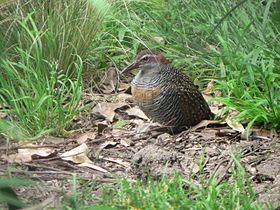The terrestrial fauna of the Cocos (Keeling) Islands is unsurprisingly depauperate, because of the small land area of the islands, their lack of diverse habitats, and their isolation from large land-masses. However, the fauna dependent on marine resources is much richer.
As a small and isolated group of islands in two atolls 24 km apart in the eastern Indian Ocean, the number of species of resident landbirds (as opposed to seabirds and waders) is very small. These comprise the endemic subspecies of buff-banded rail, the introduced green junglefowl and helmeted guineafowl, the white-breasted waterhen, eastern reef egret, nankeen night heron and the introduced Christmas white-eye. Four other introduced species are now extinct in the Islands. Several other landbird species have been recorded occasionally, but none has established a breeding population.
Migratory waders recorded in the islands include some regular visitors as well as vagrants. None breeds there. However, North Keeling is important for breeding seabirds, with sizeable numbers of red-footed boobies, great and lesser frigatebirds, common noddies and white terns. Other breeding seabirds include wedge-tailed shearwaters, masked boobies, brown boobies, red-tailed and white-tailed tropicbirds, and sooty terns. It is possible that the herald petrel breeds there as well.
Presumably, before human occupation of the islands in the 19th century, seabirds bred on both atolls. However, with the establishment of a human population and the introduction of rodents to the southern atoll, significant seabird colonies are now restricted to the northern atoll of North Keeling. Although the Cocos islanders used to visit North Keeling regularly to harvest seabirds, this practice largely ceased with the establishment of Pulu Keeling National Park in 1995.
PhasianidaeRed junglefowl, Gallus gallus - feral domestic fowlGreen junglefowl, Gallus varius - introduced, breedingHelmeted guineafowl, Numida meleagris - introduced, breedingAnatidaePacific black duck, Anas superciliosa - vagrantCommon teal, Anas crecca - vagrantHardhead, Aythya australis - vagrantProcellariidaeBulwer's petrel, Bulweria bulwerii - vagrantHerald petrel, Pterodroma arminjoniana - possibly breedingWedge-tailed shearwater, Ardenna pacificus - breedingDiomedeidaeYellow-nosed albatross, Thalassarche chlororhynchos - vagrantPhaethontidaeWhite-tailed tropicbird, Phaethon lepturus - breedingRed-tailed tropicbird, Phaethon rubricauda - breedingSulidaeMasked booby, Sula dactylatra - breedingBrown booby, Sula leucogaster - breedingRed-footed booby, Sula sula - breedingPhalacrocoracidaeGreat cormorant, Phalacrocorax carbo - vagrantLittle black cormorant, Phalacrocorax sulcirostris - vagrantLittle pied cormorant, Phalacrocorax melanoleucos - vagrantFregatidaeChristmas frigatebird, Fregata andrewsi - vagrantLesser frigatebird, Fregata ariel - breedingGreat frigatebird, Fregata minor - breedingArdeidaeGreat egret, Ardea alba - vagrantCattle egret, Ardea ibis - vagrantIntermediate egret, Ardea intermedia - vagrantChinese pond heron, Ardeola bacchus - vagrantStriated heron, Butorides striatus - vagrantLittle egret, Egretta garzetta - breeding?White-faced heron, Egretta novaehollandiae - vagrantEastern reef egret, Egretta sacra - breedingWestern reef egret, Egretta gularis - vagrantNankeen night heron, Nycticorax caledonicus - breedingBlack-crowned night heron, Nycticorax nycticorax - vagrantBlack bittern, Ixobrychus flavicollis - vagrantYellow bittern, Ixobrychus sinensis - vagrantThreskiornithidaeGlossy ibis, Plegadis falcinellus - vagrantPhoenicopteridaeGreater flamingo, Phoenicopterus ruber - vagrantAccipitridaeSwamp harrier, Circus approximans - vagrantChinese sparrowhawk, Accipiter soloensis - vagrantJapanese sparrowhawk, Accipiter gularis - vagrantFalconidaeNankeen kestrel, Falco cenchroides - vagrantRallidaeWhite-breasted waterhen, Amaurornis phoenicurus - breedingCocos buff-banded rail, Gallirallus philippensis andrewsi - endemic subspeciesWatercock, Gallicrex cinerea - vagrantScolopacidaeCommon sandpiper, Actitis hypoleucos - regular visitorRuddy turnstone, Arenaria interpres - regular visitorSharp-tailed sandpiper, Calidris acuminata - vagrantSanderling, Calidris alba - vagrantCurlew sandpiper, Calidris ferruginea - vagrantRed-necked stint, Calidris ruficollis - vagrantRed knot, Calidris canutus - vagrantGreat knot, Calidris tenuirostris - vagrantPin-tailed snipe, Gallinago stenura - vagrantGrey-tailed tattler, Heteroscelus brevipes - vagrantBar-tailed godwit, Limosa lapponica - vagrantBlack-tailed godwit, Limosa limosa - vagrantLittle curlew, Numenius minutus - vagrantWhimbrel, Numenius phaeopus - regular visitorCommon greenshank, Tringa nebularia - regular visitorCommon redshank, Tringa totanus - regular visitorRed-necked phalarope, Phalaropus lobatus - vagrantRecurvirostridaeBlack-winged stilt, Himantopus himantopus leucocephalus - vagrantCharadriidaeGreater sand plover, Charadrius leschenaultii - regular visitorOriental plover, Charadrius veredus - vagrantPacific golden plover, Pluvialis fulva - regular visitorGrey plover, Pluvialis squatarola - vagrantGlareolidaeOriental pratincole, Glareola maldivarum - vagrantLaridaeCommon noddy, Anous stolidus - breedingLesser noddy, Anous tenuirostris - vagrantWhite-winged tern, Chlidonias leucopterus - vagrantWhite tern, Gygis alba - breedingBridled tern, Onychoprion anaethetus - vagrantSooty tern, Onychoprion fuscatus - breedingCommon tern, Sterna hirundo - vagrantLesser crested tern, Thalasseus bergii - vagrantGreater crested tern, Thalasseus bengalensis - vagrantSaunders's tern Sternula saundersi - vagrantColumbidaeChristmas imperial pigeon, Ducula whartoni - introduced, extinctCuculidaeLarge hawk-cuckoo, Hierococcyx sparverioides - vagrantOriental cuckoo, Cuculus saturatus - vagrantIndian cuckoo, Cuculus micropterus - vagrantAsian koel, Eudynamys scolopaceus - vagrantStrigidaeBuffy fish owl, Ketupa ketupu - vagrantCaprimulgidaeNightjar species, Caprimulgus - vagrantApodidaePacific swift, Apus pacificus - vagrantEdible-nest swiftlet, Collocalia fuciphaga - vagrantWhite-throated needletail, Hirundapus caudacutus - vagrantHalcyonidaeCollared kingfisher, Todiramphus chloris - vagrantMeropidaeRainbow bee-eater, Merops ornatus - vagrantCoraciidaeDollarbird, Eurystomus orientalis - vagrantMotacillidaeGrey wagtail, Motacilla cinerea - vagrantYellow wagtail, Motacilla flava - vagrantPasseridaeJava sparrow, Padda oryzivora - introduced, extinctPloceidaeAsian golden weaver, Ploceus hypoxanthus - introduced, extinctHirundinidaeBarn swallow, Hirundo rustica - regular visitorAsian house martin, Delichon dasypus - vagrantZosteropidaeChristmas white-eye, Zosterops natalis - introduced, breedingTurdidaeChristmas thrush, Turdus poliocephalus erythropleurus - introduced, extinctMuscicapidaeAsian brown flycatcher, Muscicapa dauurica - vagrantBlue-and-white flycatcher, Cyanoptila cyanomelana - vagrantSturnidaeRosy starling, Pastor roseus - vagrantThere are no native land mammals. Two species of rodent, the house mouse and black rat, have been introduced to the southern atoll but are absent from North Keeling. Rabbits were introduced but have become extinct. Two species of Asian deer, the Indian muntjac (Muntiacus muntjak), and Sambar (Cervus unicolor), were introduced but did not persist. Marine mammals recorded stranding on, or seen passing by, the islands include:
SireniaDugong, Dugong dugon – seen in the lagoon of the southern atollCetaceaBottlenose dolphin, Tursiops truncatus – regularly seenCommon dolphin, Delphinus delphis – regularly seenPilot whale, Globicephala speciesHumpback whale, Megaptera novaeangliaeCuvier's beaked whale, Ziphius cavirostrisSperm whale, Physeter macrocephalusTerrestrial reptiles include three geckos and a blind-snake, all of which may have been inadvertently transported to the islands by humans:
GekkonidaeMourning gecko, Lepidodactylus lugubrisFour-clawed gecko, Gehyra mutilataHouse gecko, Hemidactylus frenatusTyphlopidaeBlind snake, Typhlops braminusMarine reptiles include:
HydrophiidaeYellow-bellied sea snake, Pelamis platurusBanded sea krait, Laticauda colubrinaChelonioideaGreen sea turtle, Chelonia mydas - breedingHawksbill sea turtle, Eretmochelys imbricataOlive ridley sea turtle, Lepidochelys olivaceaLoggerhead sea turtle, Caretta carettaLeatherback sea turtle, Dermochelys coriaceaOver 500 species of fish have been recorded around the islands.

